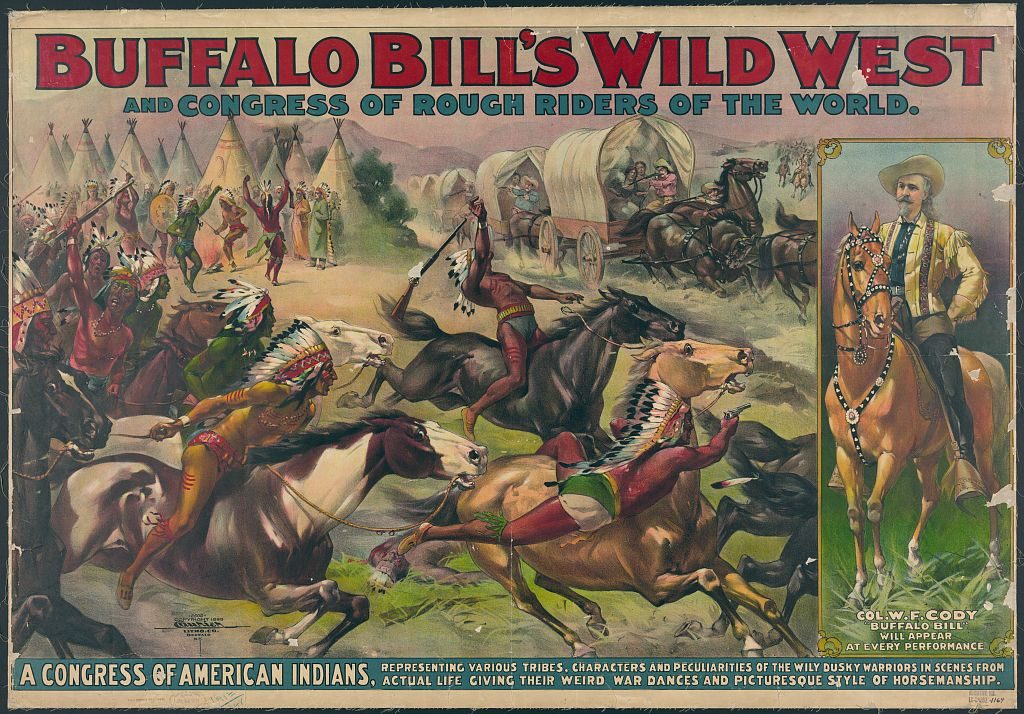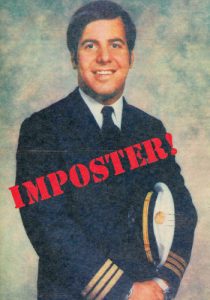In 1883, William “Buffalo Bill” Cody, famous frontiersman, army scout, and buffalo hunter, opened the doors of his Wild West Show for the first time.1 This show was a fantastical, exaggerated portrayal of life on the frontier, complete with reenactments of famous frontier battles with natives, displays by gifted marksmen (and one woman) and horsemen, and shows of the culture of the various Native Americans in Bill’s employ. This show would capture the hearts and minds of many people in the United States, and later on even in Europe, as Buffalo Bill’s show traveled to many European countries between 1886 and 1906.2

One of the reasons for the success of Buffalo Bill’s show was its “authenticity.” Bill himself was already somewhat of a celebrity in the west, after having earned his moniker “Buffalo Bill” for killing some 4,280 buffalo for the Kansas Pacific Railroad Company in the 1860s.3 Bill also had the good business sense to employ many of the Lakota Sioux and other Native Americans, including the man famous for the role he actually played at the Battle of the Little Big Horn, Chief Sitting Bull. It was in its depiction of Native Americans that many of his fans were drawn, enamored by the elaborate songs and dances of these peoples, with Buffalo Bill going so far as to say, “My Indians are the principal feature of this show.”4 The depiction of the Native Americans in his show was largely of their warrior culture, war regalia, and dances made for going into battle; however, this was taking place during the closing of the American frontier, when the death of the buffalo herds and the end of the Sioux Wars had largely ended this way of life in the west.
After roughly four months working with Cody, Sitting Bull grew tired of the show and left to return to the Standing Rock Reservation, where he would eventually be killed. Later in 1890, the Massacre at Wounded Knee would take place and many Sioux would be killed by the U.S. 7th Cavalry, the same regiment that fought with Custer years prior, at the Battle of the Little Big Horn.5 With this, the way of life that was shown in Buffalo Bill’s show was all but destroyed.

Even with this, Buffalo Bill’s Wild West Show continued to be popular up until it went bankrupt and closed in 1916.6 By 1916, the “Wild West” had not truly existed for quite some time; the country had been rapidly industrializing, and the age of both Cowboys and Indians would soon give way to the machine guns and artillery of the First World War. However, it was not the death of the west that ended Bill’s show, but rather the end of interest in the west. Although people praised Bill’s show for its authenticity, it was not authentic to the contemporary west. The show did not feature miles-long slow rides in freezing temperatures on cattle drives, and it did not show subsistence farming. What Buffalo Bill’s Wild West Show gave its audience was the same thing that they grew accustomed to from dime novels and stories of the west: rough and tumble cowboys, crack shots, skilled horsemen, and the Natives that made the west so dangerous. With the closing of the frontier and the nation looking outside of its borders to expand, the west was no longer as exotic as it once was in the public’s eye, and was anything but wild.
- Stephen G. Hyslop, “How the West was Spun,” American History 43, no. 4 (October 2008): 26. ↵
- Irene Lottini, “When Buffalo Bill crossed the ocean: Native American scenes in early twentieth century European culture,” European Journal Of American Culture 31, no. 3 (October 18, 2012): 187. ↵
- Stephen G. Hyslop, “How the West was Spun,” American History 43, no. 4 (October 2008): 27. ↵
- Stephen G. Hyslop, “How the West was Spun,” American History 43, no. 4 (October 2008): 33. ↵
- Stephen G. Hyslop, “How the West was Spun,” American History 43, no. 4 (October 2008): 33. ↵
- Douglas Seefeldt, “Buffalo Bill’s Wild West,” in America in the World, 1776 to the Present: A Supplement to the Dictionary of American History, edited by Edward J. Blum, Vol. 1. (Farmington Hills, MI: Charles Scribner’s Sons, 2016), 163. ↵



63 comments
Rawan hawsawi
It is intriguing how you bring out the integration of various people from different continents with diverse cultures through fun. I was wondering what kind of a show this is and that kept me delving further into the article. I was amazed by how the Buffalo Bill’s show was a success because of its authenticity, something so rare to find these days. You have employed too much exaggeration, I mean who can kill 4,280 buffaloes? The people depicted in the story were very much battle and war-oriented and with the time that fades depending on the rate of civilization which could be one of the factors leading to the death of the show.
Vanessa Rodriguez
In class last week, I had just learned how Buffalo Bill got his name and I was fascinated by his story. To think that his Wild West show was so loved and appreciated, it traveled all through Europe and the United States seemed crazy to me. I enjoyed how the author included the “death” of the show and why it occurred. The lack of interest in the west and not enough of what was really going on truly ended the show. Great article!
Nnamdi Onwuzurike
I just learned how Buffalo Bill got his name in my class before I read this article and it’s honestly depressing. Imagine slowly having your culture stripped from you and being unable to do anything about it. Nonetheless, I have to applaud his business skills. He realized everyone had this utopia-fueled idea about the west and he made that utopia real and turned it into a business. I do like how the Indians had the chance to be themselves, even though it was under very different circumstances. This was a very good and informative article
Nathaniel Liveris
Very good analysis! I found exaggerated nature of the show and the facade it placed over its actors to be a sinister example of abusive entertainment. The descriptions of the rapid decline of Native American culture and the ultimately shifting interests of the nation as a whole (stemming from the rise of industrialization and 20th century imperialism) to be a sober reminder of the damage done to Native culture at the expense of western entertainment.
Isabella Lopez
This was so well written! The tone of the article really set the mood for this story . I had only heard of the name “Buffalo Bill” but I never knew the story. 4,280 buffalo killed by one man is a crazy number to wrap your head around. The surprise was that he still continued even after Sitting Bulls demise. I think everything flowed very well.
Geraldine Fry
This was a very interesting article about one of the greatest shows. I wish I could have seen the Buffalo Bill’s Wild West show it sounds so cool. Sadly, interest in cowboys, stories of the dangerous west, and freedoms frontier had died out. It was nice that Native Americans were a main part of the show, even if it was ironic that Bill was in charge since had killed thousands of the Natives buffalos.
Alexandra Ballard
I had heard of Buffalo Bill before but never knew who or what it was. It’s interesting to see how new places have been romanticized throughout history. Before Buffalo Bill, it was sailors going back to Europe and speaking about the Americas like it was paradise. In modern times I see a lot of television shows that show Alaska as the last true “frontier”. So, it’s not surprising to me that Buffalo Bill’s show went bankrupt as the novelty wore off. I was impressed and surprised that he would hire tribal people!
Clarissa Liscano
Really didn’t know much about Buffalo Bill wild west show but this article did a great job at explaining it. I was able to understand how sailors in the past would visit Europe and describe the Americans as living in a paradise or heaven on earth. didn’t last long because the show was shut down. Even though Bill did slaughter tens of thousands of native buffalo, it was nice to know that Native Americans played a significant role in the show. Fantastic article.
Griffin Palmer
Buffalo Bill’s Wild West Show contributed heavily to cowboy and Indian entertainment. It showed the interesting ways of living in the west especially as cowboy fighting against the Indians. It also shows recognition towards the ghost dances the Indians did during the time creating fear in white men. This would help to draw more people to the west to try out the way of life in the west.
Marissa Rendon
After reading this article i feel like it would be a pretty interesting show to watch. I was sad to hear that the show basically fell off since they became bankrupt. The effort that was put into the show is everything. You can tell by reading that Bill put in his absolute all into this.
Karly West
I remember hearing about this show from my grandfather, I had no idea what it was but learning how much history is behind this show is fascinating. I think Buffalo Bill was a great marketing tool for western culture by painting the show as authentically western. I’m surprised that they ended the show early due to disinterest, it seemed like there were many people influenced by Buffalo Bill’s show. Great job!